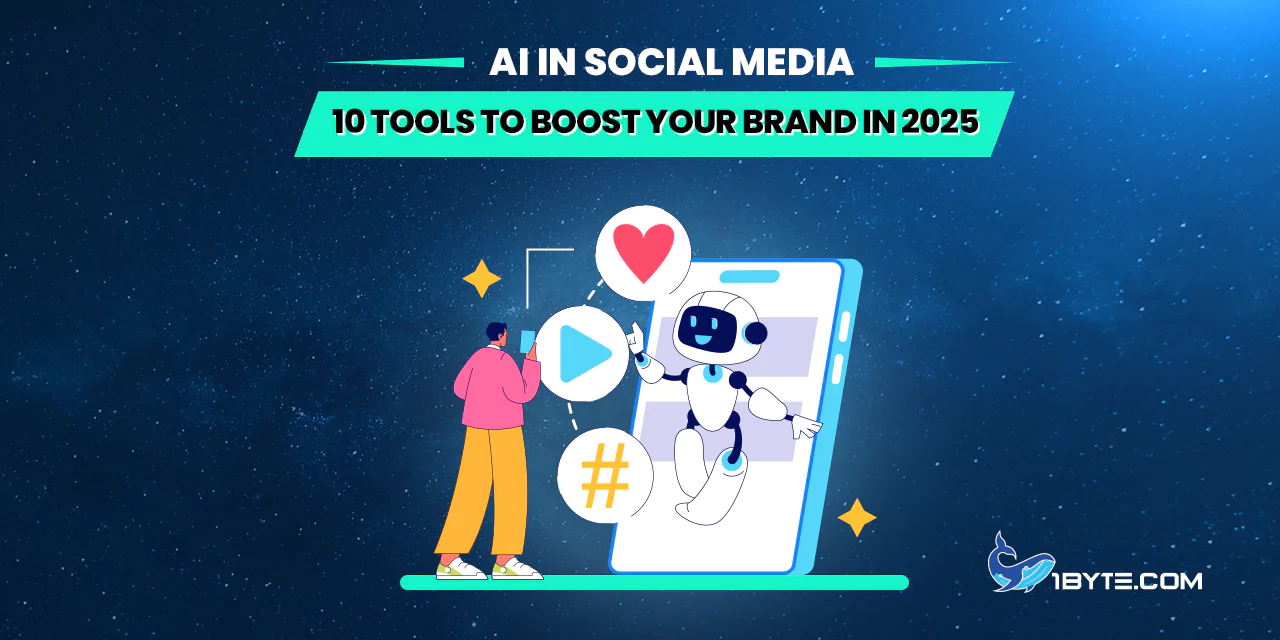-
10 AI Tools to Boost Your Brand on Social Media
- 1. Sprout Social – AI-Powered Social Media Management
- 2. Hootsuite (OwlyWriter AI) – Intelligent Scheduling and Analytics
- 3. Buffer (AI Assistant) – Smarter Content Tailoring for Each Channel
- 4. Brandwatch – AI Social Listening and Consumer Insights
- 5. Rival IQ – AI Competitor Benchmarking and Performance Tracking
- 6. HypeAuditor – AI-Driven Influencer Marketing Analytics
- 7. ChatGPT – Generative AI for Content Creation and Ideas
- 8. Canva (Magic Studio) – AI Design and Visual Content Creation
- 9. InVideo – AI-Powered Video Creation and Editing
- 10. ManyChat – AI Chatbot for Social Media Engagement
- Conclusion
Artificial Intelligence (AI) is rapidly becoming a cornerstone of social media strategy for brands. Marketing teams are using AI in social media to save time, streamline content creation, and improve engagement. In fact, 61% of organizations say their top reason for adopting AI in social media is to reduce staff workload, and 38% of marketers report increased efficiency as the main benefit. Businesses that use AI to generate social content even see a 15–25% boost in engagement rates on average. These figures show why embracing AI is essential for brands that want to stay competitive on social platforms in 2025.
From content creation to customer service, AI in social media is helping brands connect with audiences more effectively and efficiently. It’s no surprise that 65% of marketers use AI tools weekly or more often, and 74% plan to increase their use of generative AI over the next year. Brands are investing in these tools to gain an edge – the global market for AI in social media is on track to nearly $12 billion by 2031. Clearly, AI-powered social media tools have moved from experimental to essential by 2025.
AI tools for social media include a variety of platforms and assistants, as illustrated by the logos of Buffer, Hootsuite, and other top apps in 2025. These tools span content creation, scheduling, analytics, social listening, and more. Below is a list of 10 AI-driven tools (in no particular order) that are boosting brand performance on social media. Each tool is relevant and impactful as of 2025, helping brands large and small save time, reach the right audience, and create engaging content. The list includes a mix of platforms for managing social media and specialized AI assistants for content, visuals, and customer engagement. Read this article from 1Byte to find out more.
10 AI Tools to Boost Your Brand on Social Media
Below, we delve into how each of these AI tools works and how it’s helping brands on social media in 2025. From specific examples to recent statistics, you’ll see why these tools stand out. By understanding what each tool offers, your team can choose the right ones to amplify your brand’s social media presence.
1. Sprout Social – AI-Powered Social Media Management
Sprout Social is a leading social media management platform that has integrated AI across its features. It acts as an intelligent assistant for social media teams, combining scheduling, analytics, and social listening in one place. Sprout Social’s AI helps brands streamline their workflow: marketers can automate routine tasks (like queuing posts or flagging messages) and focus on high-level strategy. For example, Sprout’s platform automatically suggests optimal post times using its patented ViralPost® algorithm, which analyzes audience engagement patterns to maximize visibility. Instead of guessing when to post, teams rely on data-driven AI recommendations to reach followers when they’re most active.
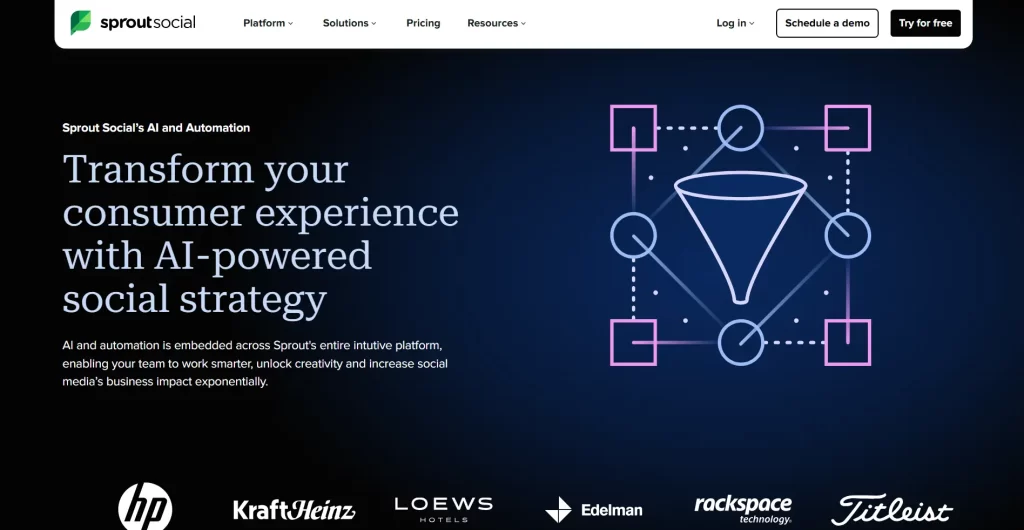
Another powerful feature is Sprout’s AI-driven social listening. The tool processes an average of 600 million social messages per day to identify trends and sentiments. Using machine learning and natural language processing, Sprout Social monitors brand mentions and customer conversations in real time. Marketers get alerts about surges in positive or negative sentiment, so they can react quickly. This has a direct impact on brand health – by catching a wave of negative comments early, a company can address issues before they escalate. Sprout’s platform even uses named entity recognition to filter and prioritize relevant chatter. Brands using Sprout gain actionable insights about what their audience cares about and how they feel, informing everything from product improvements to campaign messaging.
Timely customer engagement is another area where Sprout’s AI makes a difference. Its Smart Inbox uses algorithms to categorize and prioritize incoming social messages, helping community managers respond faster. Speed matters because nearly 75% of consumers expect a response on social media within a day. Sprout Social enables brands to meet these expectations by ensuring no important message gets buried. The result is better customer service and higher satisfaction. Notably, 76% of consumers notice and appreciate when companies prioritize support on social media. By using Sprout’s AI to quickly handle inquiries and comments, brands build loyalty and trust with their audience.
2. Hootsuite (OwlyWriter AI) – Intelligent Scheduling and Analytics
Hootsuite is one of the most established social media management tools, and in 2025 it’s keeping pace by integrating AI features to help brands. Its built-in AI, known as OwlyWriter, acts as a virtual copywriter for social media content. Instead of starting from scratch, marketers can use OwlyWriter to generate post ideas, captions, or even entire social posts tailored to different platforms. For example, you can prompt the AI for a tweet about an upcoming product launch, and it will suggest engaging text – complete with relevant hashtags or emojis – which you can then refine to match your brand voice. This dramatically speeds up content creation. A social media manager who used to spend hours writing copy can now produce posts in a fraction of the time, ensuring the brand stays consistently active across channels.
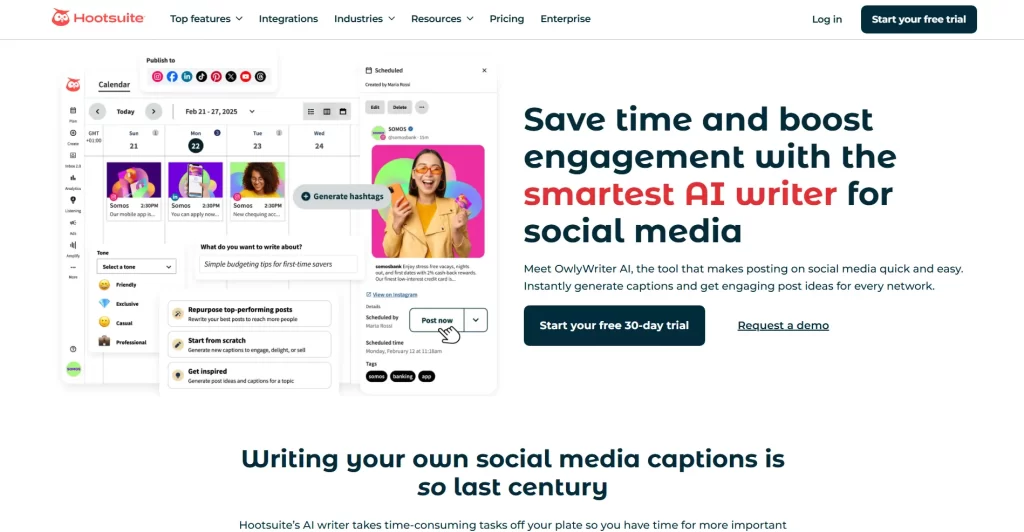
Beyond content writing, Hootsuite employs AI to enhance its robust analytics dashboard. The tool automatically analyzes your social media performance and highlights important trends. It can identify which types of posts are performing best or what time of day yields the highest engagement for your brand. Hootsuite also uses AI for competitor benchmarking and trend spotting. It monitors industry rivals and uses machine learning to compare their engagement metrics to yours. These insights show where you have an edge and where you might need to improve. For instance, if a competitor’s posts on a certain topic consistently outperform yours, Hootsuite’s analytics will surface that information. Your team can then tweak your strategy – perhaps by adopting similar content themes or posting at similar times – to boost results.
In summary, Hootsuite in 2025 is far more than a scheduling tool – it’s an AI-enhanced system that writes, analyzes, and optimizes social media content. Its longevity and widespread adoption mean there’s a strong support community and continuous improvement. For brands, using Hootsuite’s AI features translates to less guesswork and more strategy grounded in data. By automating content ideas and surfacing actionable insights, Hootsuite helps companies maintain a strong and informed social media presence with less manual effort.
3. Buffer (AI Assistant) – Smarter Content Tailoring for Each Channel
Buffer has long been a favorite for solo marketers and small teams to schedule posts, and now it’s augmented with AI capabilities that make social media management even easier. Buffer’s AI Assistant focuses on content optimization – it helps brands tailor posts for each social platform and suggests improvements before anything goes live. The assistant can take a base piece of content (say a new blog announcement or a product photo) and adapt the caption style to suit Twitter, Facebook, Instagram, and LinkedIn individually. This is crucial because an overly long Facebook-style caption wouldn’t work on Twitter, and an overly formal LinkedIn tone might flop on Instagram. Buffer’s AI ensures each post is right-sized and phrased for its intended network, automatically. Marketers get polished, channel-specific drafts that they can approve or tweak, saving time and maintaining a consistent message.
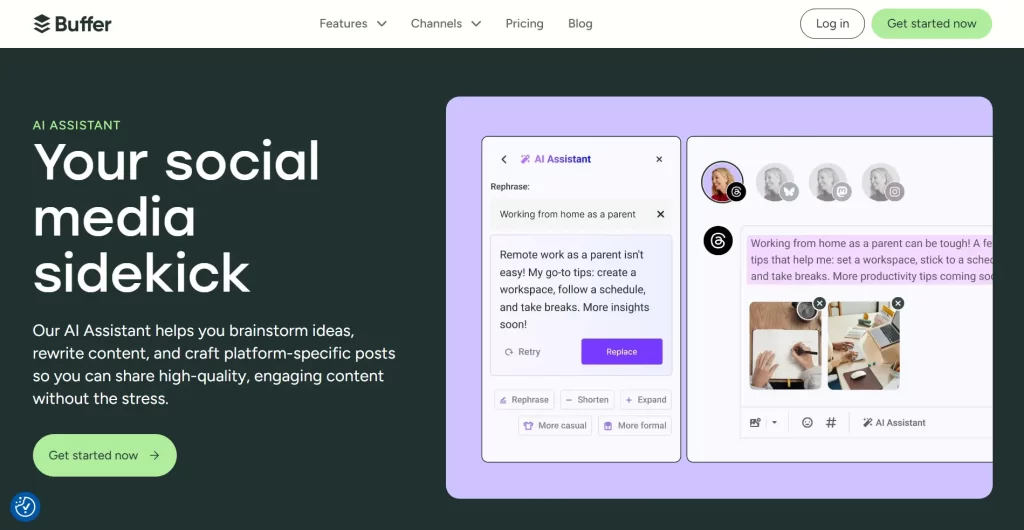
Another helpful feature is hashtag and keyword suggestions. Buffer’s AI analyzes trending topics and past post performance to recommend hashtags that could increase a post’s reach. For example, if you’re a travel brand sharing photos of Paris, the AI might suggest popular hashtags like #TravelTuesday or #ParisVacay that you hadn’t considered, potentially boosting discovery. It also learns from your account’s history – if posts with certain keywords perform better, Buffer will encourage you to incorporate those terms more often. This kind of data-driven guidance can lead to higher engagement since content is optimized based on what actually works.
Buffer remains simple and user-friendly, which is part of its appeal to general brands. A real-world scenario: imagine a local restaurant using Buffer to handle their social updates. They have a limited marketing team, perhaps just one person. With Buffer’s AI, that marketer can generate a week’s worth of posts in one sitting. The AI might create a cheerful, emoji-filled blurb for an Instagram post about a new menu item, then craft a more informative, hashtag-rich version for Twitter – all from the same initial idea. The marketer can review these suggestions, feel confident that they’re aligned with platform best practices, and schedule them. Buffer will even predict how the posts might perform and suggest the best times to publish, thanks to machine learning from thousands of users’ data.
4. Brandwatch – AI Social Listening and Consumer Insights
Brandwatch is a powerful tool for social listening, and it leverages AI to help brands monitor and analyze conversations happening about them (and their industry) across the internet. In 2025, social media isn’t just about what you post – it’s about what your customers and the public are saying. Brandwatch uses AI-driven analytics to sift through millions of data points in real time, from tweets and Instagram comments to forum discussions and news articles. This enables a brand to get a true read on public sentiment and emerging trends. If you’ve ever wondered what people really think of your latest campaign or why a competitor is suddenly getting buzz, Brandwatch’s AI can surface those insights quickly.
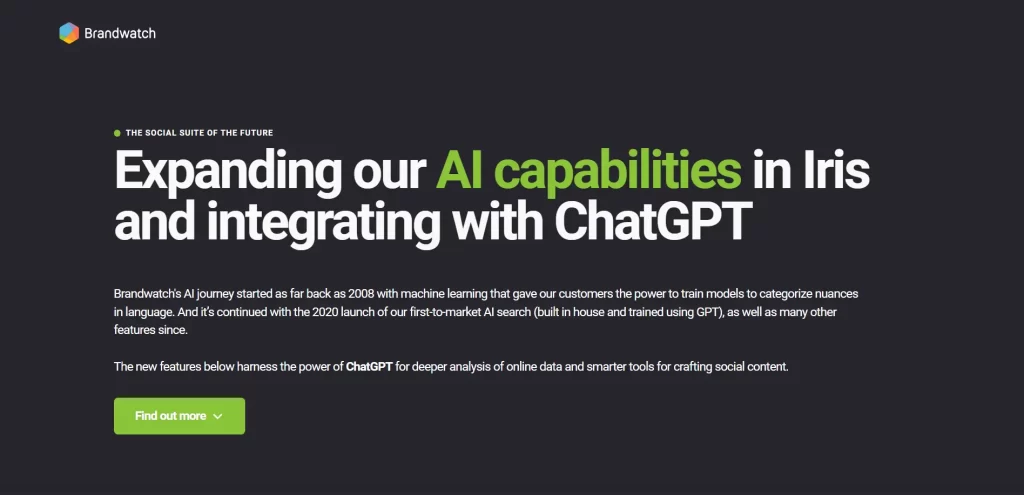
One of Brandwatch’s key features is its sentiment analysis. Using natural language processing (NLP), the tool automatically classifies mentions of your brand as positive, negative, or neutral. And it doesn’t stop at simple keywords – the AI understands context, sarcasm, and slang more accurately than traditional tools. For example, if someone tweets “Their customer service is sick!” the AI can recognize that in modern slang, this is likely praise (positive sentiment) rather than criticism about illness. This level of nuance means brands get a more accurate picture of their reputation. Companies have used Brandwatch to track sentiment during product launches or PR crises. A notable benefit: by identifying a sudden spike in negative sentiment early, a brand can activate its crisis response or clarify information before things spiral further.
Brandwatch also excels at trend detection. Its AI looks for unusual increases in particular topics or hashtags related to your business. Suppose you are a beverage brand, and overnight there’s a surge in mentions of your drink alongside the word “allergy”. Brandwatch could flag this anomaly immediately, allowing you to investigate (maybe someone had a reaction that’s going viral) and respond. In contrast, without AI, you might not notice this trend until it’s much larger and potentially more damaging. On the positive side, trend detection can alert you to opportunities. Brandwatch might discover a growing conversation about an ingredient you use (“collagen” or “oat milk” for instance). Seeing interest rise, you could jump in with relevant content or even product development geared to that trend.
5. Rival IQ – AI Competitor Benchmarking and Performance Tracking
Rival IQ is an analytics tool that uses AI to help brands understand how they stack up against the competition on social media. In the fast-paced social landscape of 2025, it’s not enough to track your own likes and shares – you need to know what your rivals are doing and how well it’s working for them. Rival IQ automates the heavy lifting by continuously gathering data on competitors’ social media performance and presenting it in easy-to-digest comparisons. This includes metrics like follower growth, posting frequency, engagement rates, and top-performing content across platforms. With AI, Rival IQ can spot patterns and anomalies in those metrics, giving you strategic insights.

For instance, Rival IQ might reveal that a competitor’s engagement on Instagram spiked by 50% last week. Its AI will highlight that spike and point out what caused it – maybe the competitor launched a giveaway campaign or a viral video. Knowing this almost in real time is incredibly valuable. Your brand can quickly devise a countermeasure, such as ramping up your own content or analyzing that campaign to learn best practices. Essentially, Rival IQ ensures you are never caught off guard by a competitor’s move. It’s like having a watchtower overlooking the entire competitive field, with AI binoculars zooming in on key activities.
One of Rival IQ’s strengths is providing industry benchmarks so you can gauge what “good” looks like in your space. The tool aggregates data from many brands to tell you, for example, what the average engagement rate is in your industry on each platform. Say you operate a retail brand: Rival IQ might show that the median Instagram engagement rate for retail is 0.5% while TikTok’s median is 5%. Knowing this, if your Instagram engagement is 0.8%, you’re actually above average – a confidence boost. But if your TikTok engagement is only 2%, you’re below the typical benchmark, indicating room to improve. These context-rich insights prevent you from making false judgments. Without industry context, one might think 0.8% engagement is low in absolute terms, but relative to peers it’s strong.
Moreover, Rival IQ’s AI identifies what content topics or formats are working for your competitors. It might detect that across all competitors, posts about a certain theme (say sustainability, or a trending meme) are getting unusually high engagement this month. This suggests a content opportunity for your brand – you could ride the wave with your own take on that theme. The tool can also flag if a competitor suddenly increases their posting volume or ad spend (if detectable via engagement spikes), which might imply a big push or new product launch. Early knowledge of such moves can inform your own timing and messaging.
6. HypeAuditor – AI-Driven Influencer Marketing Analytics
Influencer partnerships have become a staple of social media marketing, and HypeAuditor is an AI-powered platform that helps brands do this effectively and safely. By 2025, the influencer landscape is vast and tricky – there are millions of creators, and not all of them have genuine followings or the right audience for your brand. HypeAuditor’s AI tackles this by analyzing influencer profiles in depth, detecting fake followers, and assessing the quality of their engagement. This means brands can find trustworthy influencers whose audience demographics and interests align with their target market.
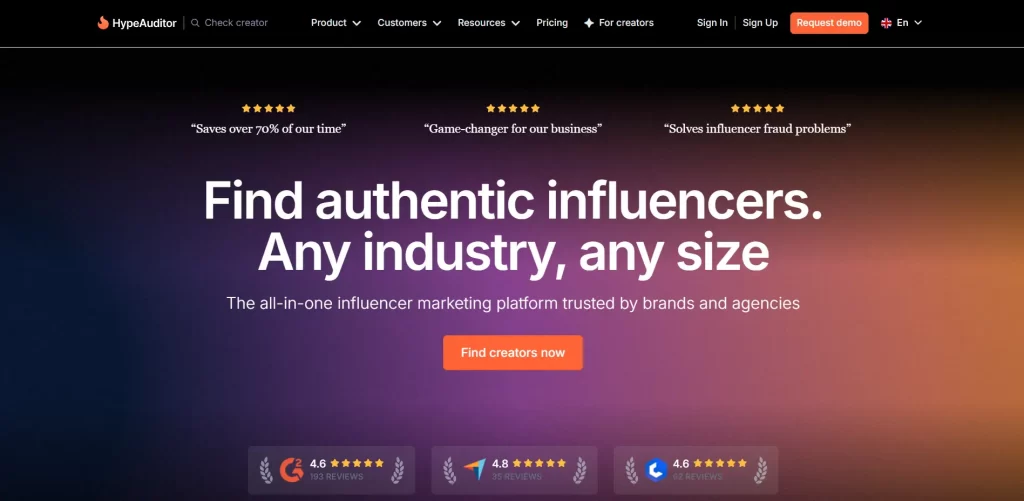
One of HypeAuditor’s primary uses is to vet influencer authenticity. Its machine learning algorithms look at patterns in an influencer’s follower list and engagement. If an account has a suspiciously high number of bot-like followers (accounts with no profile pics, odd usernames, or following thousands of others), HypeAuditor will flag it. Likewise, it can tell if an influencer’s comments are mostly generic (“Nice pic!”, “Cool!” repeated over and over) which is a red flag for engagement pods or fake engagement. By screening these factors, HypeAuditor saves brands from wasting budget on influencers who might have inflated metrics. This protects a brand’s investment – ensuring that when they pay for a promotion, they’re getting access to real human audiences who might actually become customers.
HypeAuditor also provides rich analytics on influencer audiences. For any given influencer, a brand can see the breakdown of their followers: age, gender, location, interests, and even brand affinities. For example, a cosmetics company could use HypeAuditor to find beauty vloggers whose audience is, say, 90% women, mostly 18–34 years old, with an interest in cruelty-free products. That level of detail helps in choosing the perfect partner for a campaign. Moreover, HypeAuditor ranks influencers by various performance metrics. If you want to know who the top TikTok creators in “fitness” are, HypeAuditor can list them and show engagement rates. This beats manual search and guesswork – the AI combs through data to highlight influencers who truly drive interactions, not just those with big follower numbers.
The impact on brands is significant. Companies that use HypeAuditor are able to run more efficient and high-ROI influencer campaigns. A HypeAuditor report highlighted that Instagram influencer marketing can return an average of $4.12 for every $1 spent, but that kind of ROI is only achievable when the influencer is well-chosen. By using AI to pick partners, brands increase the likelihood of strong results. For example, a fashion brand might use HypeAuditor to narrow down a list of micro-influencers who have above-average engagement (meaning their followers actively like and comment) and a follower base that overlaps with the brand’s target demographic. Partnering with these influencers could yield a surge in referral traffic and sales, validating the data-driven approach.
7. ChatGPT – Generative AI for Content Creation and Ideas
OpenAI’s ChatGPT has become one of the most transformative tools for content creation since its debut, and by 2025 it’s an indispensable assistant for many social media teams. While not a social media platform itself, ChatGPT is an AI model that can generate human-like text based on prompts – effectively acting as a creative partner for marketers. Brands use ChatGPT to brainstorm social media post ideas, write engaging captions, craft responses to customers, and even outline entire content calendars. Its strength lies in quickly producing text that would take a human much longer to write from scratch.
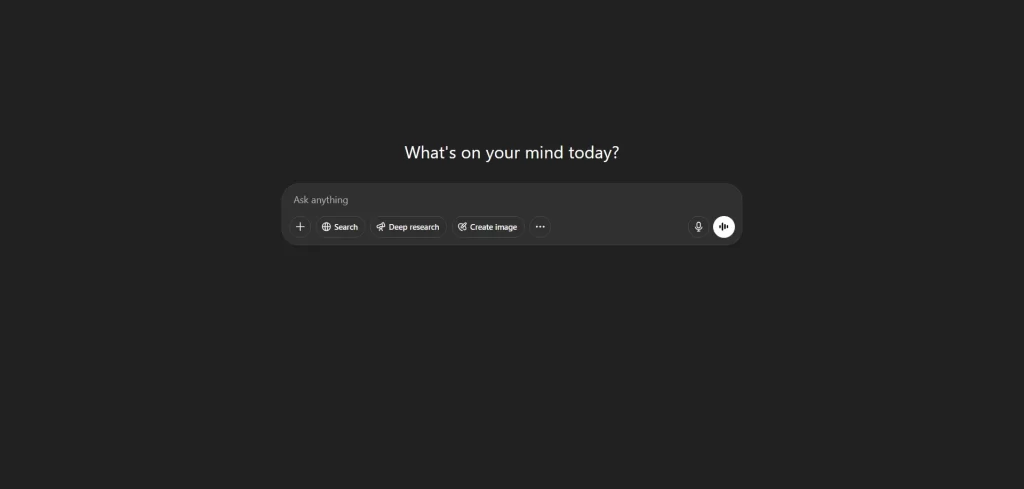
One major advantage of ChatGPT is its ability to adapt to different tones and styles. Need a witty one-liner for Twitter? A professional announcement for LinkedIn? A playful caption with puns for Instagram? ChatGPT can do all of these with the right guidance. Marketers often start by feeding ChatGPT some background: a description of their brand voice and the key message or product to highlight. The AI then generates suggestions which the marketer can refine. For example, a coffee brand could prompt, “Announce our new cold brew flavor in a fun, enthusiastic tone.” ChatGPT might reply with several options of varying creativity. This not only saves time but can also break writers’ block – giving human creators fresh angles they hadn’t considered.
The tool’s impact is evident in productivity stats. According to industry surveys, 65% of marketers use AI tools like ChatGPT daily or weekly, indicating how routine it has become. By delegating first drafts to ChatGPT, social media managers can iterate faster. For instance, instead of spending an hour wording a Facebook post perfectly, they can generate a draft in seconds, then spend 10 minutes polishing it. Over many posts and multiple channels, this efficiency adds up to hours saved each week. Furthermore, ChatGPT can help maintain content volume and consistency. Even if inspiration is running low, the AI can churn out on-brand content to fill the calendar, ensuring the brand stays visible and active.
The popularity of ChatGPT and similar AI models exploded over the past couple of years – it famously reached 100 million users within two months of launch, making it the fastest-growing app at that time. That means many people (including your audience) are now familiar with AI content. Brands are careful to use ChatGPT in a way that augments their creativity rather than replaces it. When done right, AI-assisted content can actually enhance quality: you’re not skipping the human element, you’re just turbocharging it with AI suggestions and efficiency. Given that 74% of marketers plan to increase their use of generative AI, tools like ChatGPT are likely to remain central to social media strategies. They empower brands to produce more content, maintain a consistent voice, and experiment with new ideas – all critical for boosting a brand’s presence in the crowded social media arena.
8. Canva (Magic Studio) – AI Design and Visual Content Creation
Visual content is king on social media, and Canva has long been a go-to design tool for marketers. In 2025, Canva’s Magic Studio features bring AI into the mix, making graphic design and image creation faster and more accessible than ever for brands. Canva’s AI capabilities help with everything from generating images and illustrations to suggesting design layouts and writing ad copy. This means even a small business without a dedicated designer can create polished, professional-looking visuals for their social channels, leveraging AI as a creative assistant.
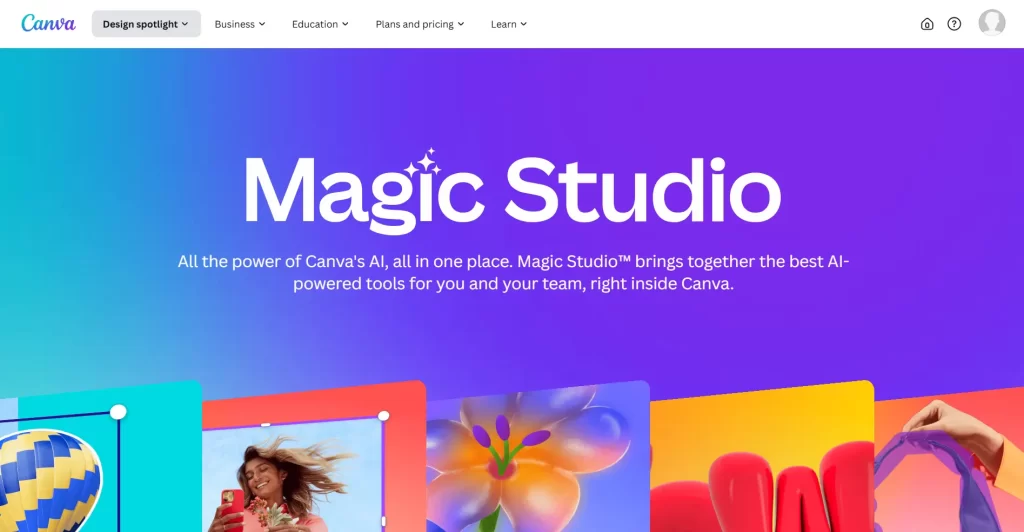
One standout feature is Canva’s text-to-image generation. Powered by AI models (including integrations of tools like DALL·E), Magic Studio lets you create unique imagery by simply describing what you need. For example, a marketer could type “a futuristic city skyline at sunset, in watercolor style” and the AI will generate a custom image matching that description. This is a game-changer for social media where fresh visuals are constantly needed – think Instagram posts, story backgrounds, or blog graphics. Instead of scouring stock photo libraries for something that fits, brands can create on-demand, original visuals that align perfectly with their message or aesthetic. It’s also useful for prototyping an idea: you can quickly mock up a concept image and then refine it or hand it off to a designer if needed. The bottom line is faster content production and greater creative flexibility.
The influence of AI-driven design on social media is huge. It’s estimated that 71% of social media images are now AI-generated or edited, showing how quickly these tools have been adopted in content creation. Brands are using Canva to churn out visual content at scale: from daily story posts to multi-slide carousel ads. For example, a travel agency can use Canva’s AI to produce attractive images of destinations with overlaid quotes or tips, maintaining a steady flow of engaging content without needing a photographer for every post. If a sudden trend pops up (like an internet meme or a viral challenge), that agency can react immediately by designing a playful graphic riding on that trend, using Canva templates and AI art, rather than missing the moment due to design lead times.
Another great use case is A/B testing different creative concepts. With AI making it so quick to generate variations, a brand can create multiple versions of a social media ad – different background images, colors, or slogans – and test which one resonates more with their audience. Canva simplifies this by allowing rapid iteration. If one version shows significantly higher engagement, the team can quickly pivot to use that style more going forward. This data-driven creativity ensures the visuals aren’t just pretty, but effective too.
9. InVideo – AI-Powered Video Creation and Editing
Video content is booming on social media, from TikTok and Instagram Reels to YouTube and Facebook videos. InVideo is a tool that harnesses AI to help brands create videos quickly and efficiently, even if they don’t have a big production budget or video editing expertise. It’s essentially an AI video maker that can transform scripts, images, or clips into polished videos complete with transitions, music, and effects. This enables brands to tap into the high engagement of video content without the usual time and cost barriers.
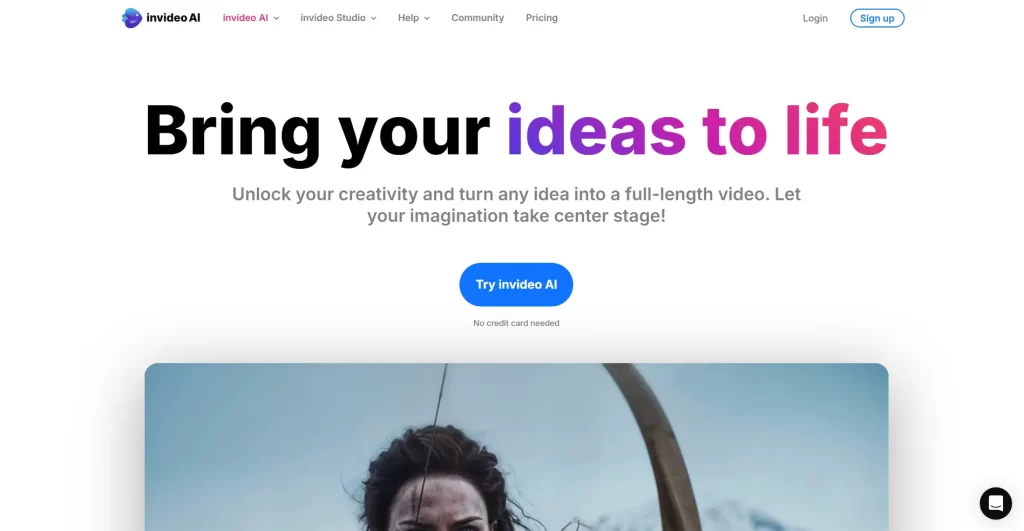
One of InVideo’s most impressive capabilities is its text-to-video feature. You can input a written script or even just a series of bullet points, and the AI will auto-generate a video sequence around it. For example, a company could provide a few lines about a product (“Introducing our new running shoes – 20% lighter, water-resistant, available now”) and InVideo will produce a short promo video. The AI selects relevant stock footage or animations (like someone running on a trail for this case), adds the text as dynamic captions or overlays, and syncs it with appropriate background music. In a matter of minutes, you have an attention-grabbing video ready for social media. Of course, you can fine-tune the scenes or upload your own footage, but the heavy lifting of initial video assembly is done by AI.
Another way InVideo uses AI is through smart editing suggestions. If you upload your own video clips, InVideo can automatically trim silences or dull moments, highlight the best parts, and suggest an order that tells a compelling story. It can also recommend color filters and graphic styles that match the mood of your content. Say you have a bunch of raw clips from a recent event your brand hosted – interviews, crowd shots, product demos. InVideo might analyze those and suggest a 60-second highlight reel: starting with an energetic crowd shot, then a couple of soundbites from interviews (transcribing and captioning them), followed by the product demo action, and closing with your logo and tagline. This kind of editing normally requires a skilled human editor, but AI can now handle much of it, dramatically speeding up the content creation cycle.
The impact is that brands can produce more video content and keep up with social trends. Video often sees higher engagement than static images; for instance, social videos generate 1200% more shares than text and image content combined (a widely cited stat in digital marketing). With InVideo, a brand’s social media manager can turn a single idea or piece of news into a video for multiple platforms in a lunch break. If there’s a trending meme format or challenge (like those TikTok trends where a certain style of video is popular), the team can quickly plug into it by using InVideo’s templates and AI to replicate the format with their own spin. Speed is crucial here – being a week late to a trend might diminish its benefit.
10. ManyChat – AI Chatbot for Social Media Engagement
Engaging with customers one-on-one is a big part of building a brand on social media. ManyChat is an AI-powered chatbot platform that helps brands automate and enhance these interactions, especially on messaging channels like Facebook Messenger, Instagram Direct, and WhatsApp. In 2025, consumers expect swift, 24/7 responses from brands online – and AI chatbots like ManyChat enable companies to meet those expectations without needing a round-the-clock human team. It’s essentially an AI customer service and marketing assistant operating through social media DMs.
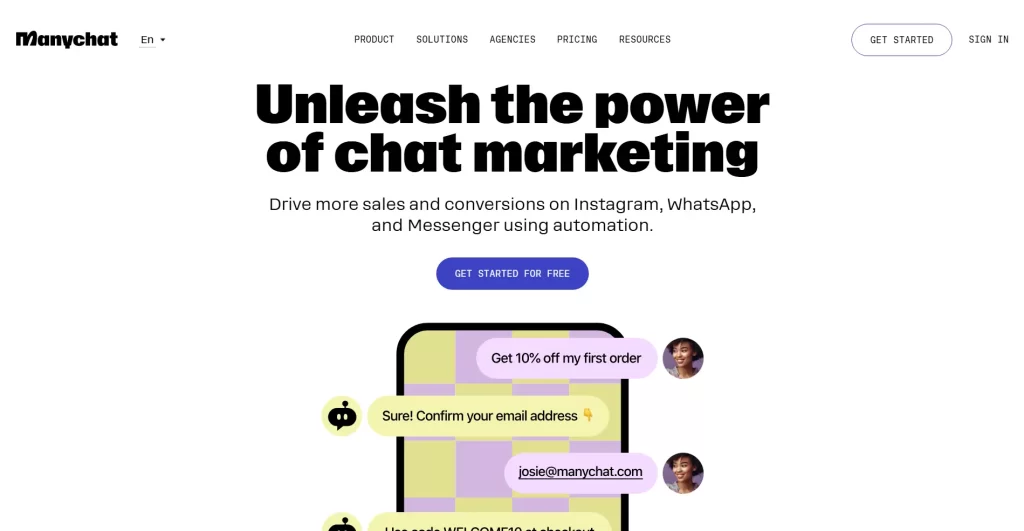
ManyChat allows brands to create conversational flows that can answer frequently asked questions, provide product information, take orders, or even just entertain users. What makes it intelligent is the integration of natural language understanding. ManyChat’s AI can interpret what a user types and respond with the most relevant pre-built answer. For example, if someone messages a clothing brand on Instagram with “Do you have this jacket in size M?”, the AI can pick up on keywords like “jacket” and “size M” and immediately reply with availability or a link to that item in medium. If the question is more complex, the chatbot can ask follow-up questions or, if needed, seamlessly hand off to a human agent. This ensures customers get help instantly for common queries while important or sensitive issues still receive a human touch.
From a brand’s perspective, one huge benefit is speed and consistency. Studies show chatbots can respond to inquiries 3 times faster than human agents, and they never have an off day. This quick response is crucial on social media; a user who comments or messages is likely to move on if they don’t hear back soon. With ManyChat, brands can maintain near-instant response times, which boosts customer satisfaction. In fact, 51% of consumers say they prefer interacting with bots for immediate service needs. So providing that option can be a competitive advantage. Moreover, the responses are always on-brand and accurate according to the latest info you feed the system, reducing the chance of human error or inconsistency.
Leverage 1Byte’s strong cloud computing expertise to boost your business in a big way
1Byte provides complete domain registration services that include dedicated support staff, educated customer care, reasonable costs, as well as a domain price search tool.
Elevate your online security with 1Byte's SSL Service. Unparalleled protection, seamless integration, and peace of mind for your digital journey.
No matter the cloud server package you pick, you can rely on 1Byte for dependability, privacy, security, and a stress-free experience that is essential for successful businesses.
Choosing us as your shared hosting provider allows you to get excellent value for your money while enjoying the same level of quality and functionality as more expensive options.
Through highly flexible programs, 1Byte's cutting-edge cloud hosting gives great solutions to small and medium-sized businesses faster, more securely, and at reduced costs.
Stay ahead of the competition with 1Byte's innovative WordPress hosting services. Our feature-rich plans and unmatched reliability ensure your website stands out and delivers an unforgettable user experience.
As an official AWS Partner, one of our primary responsibilities is to assist businesses in modernizing their operations and make the most of their journeys to the cloud with AWS.
Conclusion
The social media landscape in 2025 is more dynamic and data-driven than ever. As we’ve explored, AI in social media is not a future concept – it’s happening now, and it’s delivering real benefits to brands that embrace it. The ten tools covered above illustrate the many facets of AI’s impact. From content creation (text, images, videos) to scheduling, analytics, listening, and customer engagement, AI is helping brands work smarter, not harder. These tools enable even lean marketing teams to execute strategies that were once feasible only for companies with large resources. By automating routine tasks and providing intelligent insights, AI frees up human marketers to be more creative and strategic. It’s no wonder that marketers widely endorse these benefits – a majority cite reduced workload and improved efficiency as key gains from using AI in social media.
Importantly, the success stories aren’t confined to a specific industry. Whether it’s a fashion retailer using HypeAuditor to find authentic influencers, a tech startup using Sprout Social to derive insights from social data, or a local restaurant using Canva and ChatGPT to craft daily posts, brands of all types are boosting their social presence with AI. New statistics reinforce this trend: for instance, businesses using AI-generated social content report notable jumps in engagement, and chatbots are handling an increasing share of customer inquiries with high satisfaction rates. Meanwhile, AI-driven analytics ensure that companies aren’t flying blind – decisions on when to post, what content to create, or which audiences to target can be backed by concrete data.

